I. Introduction: Inflammation—The "Hidden Catalyst" of Chronic Diseases
In modern medical research, inflammation has been identified as a key driver in the development of numerous chronic diseases. From arthritis to cardiovascular diseases, inflammation is implicated in approximately 50% of global deaths. While traditional anti-inflammatory drugs can effectively mitigate inflammation, their long-term use often leads to adverse side effects.
Recently, a study published in the journal Life Sciences has shed light on the novel anti-inflammatory mechanisms of 6S-5-methyltetrahydrofolate calcium (Magnafolate® Pro, MTHF-Ca), offering a promising new avenue for safe and effective anti-inflammatory therapies.

II. Experimental Design: Dual Validation with Cellular and Animal Models
To thoroughly investigate the anti-inflammatory effects of active folate, the research team employed a combination of cellular experiments and in vivo animal models.
In the cellular experiments, lipopolysaccharide (LPS) was used to activate mouse macrophages (RAW264.7), mimicking the inflammatory "cytokine storm" observed in humans. Macrophages, a crucial component of the immune system, trigger a cascade of inflammatory responses when stimulated by LPS.
For in vivo experiments, transgenic zebrafish were utilized. These zebrafish have neutrophils that fluoresce green and macrophages that fluoresce red, allowing researchers to visually track the dynamics of inflammation in real-time through in vivo imaging. With an 82% genetic similarity to humans in inflammatory pathways, zebrafish are internationally recognized as a "gold standard" model for drug screening.

III. Anti-inflammatory Mechanism: Multi-Dimensional Precision Targeting of the Inflammatory Cascade
(1) Turning Off the "Inflammatory Master Switch" NF-κB
NF-κB is a pivotal transcription factor in the inflammatory response. Once activated, it migrates to the cell nucleus and initiates the expression of multiple pro-inflammatory cytokines. The study revealed that 0.62 mM of Magnafolate® Pro (MTHF-Ca) significantly inhibits the translocation of NF-κB p65 to the nucleus, achieving an effect comparable to that of 5 μg/mL dexamethasone.
The mechanism of MTHF-Ca involves stabilizing the IκBα protein, effectively "locking" NF-κB in the cytoplasm and preventing it from entering the nucleus to promote inflammation. This finding underscores MTHF-Ca's core role in inflammation regulation, fundamentally curbing the production of inflammatory factors.
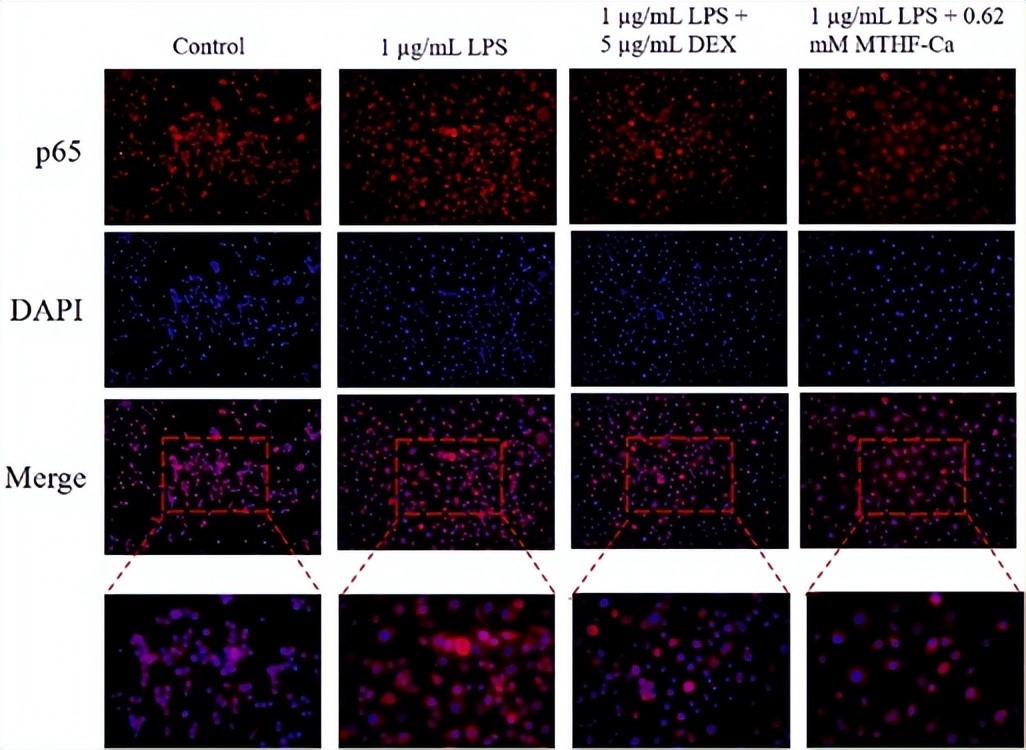
(2) Inhibiting the Inflammatory Cytokine Storm
In the LPS-stimulated model, Magnafolate® Pro demonstrated remarkable anti-inflammatory efficacy. Compared to the 1 μg/mL LPS-stimulated group, treatment with 0.62 mM MTHF-Ca reduced the levels of key inflammatory cytokines IL-1β, TNF-α, and IL-6 by 29.02%, 43.06%, and 38.37%, respectively. Notably, these reductions were more pronounced than those observed with 5 μg/mL dexamethasone treatment.
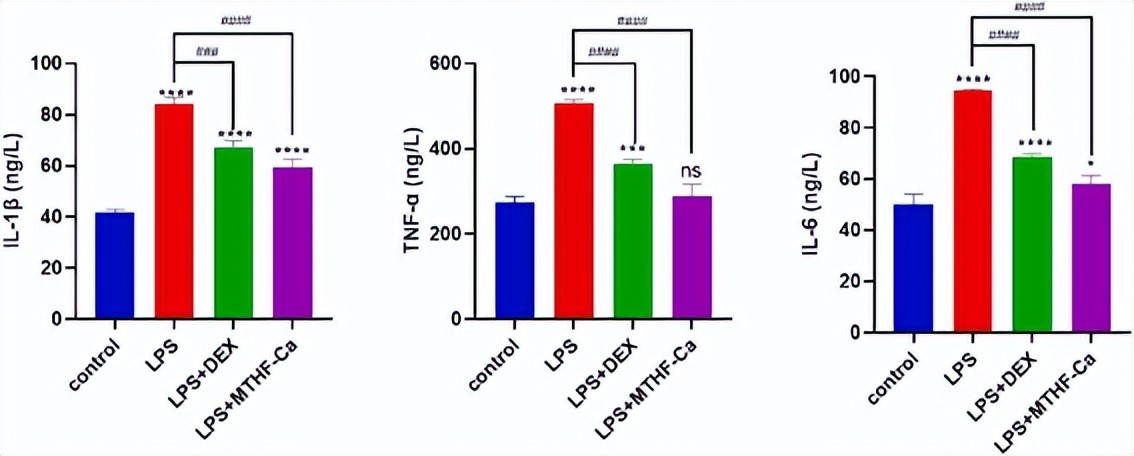
(3) Scavenging Free Radicals and Protecting Cells
Reactive oxygen species (ROS) play a detrimental role in the progression of inflammatory diseases. The study found that MTHF-Ca significantly reduces ROS accumulation in both cellular and zebrafish models.
In cellular experiments, 0.62 mM MTHF-Ca decreased ROS levels in RAW264.7 cells by 14.56%. Compared to the 1 μg/mL LPS group, MTHF-Ca inhibited ROS accumulation in a dose-dependent manner at concentrations of 0.15, 0.31, and 0.62 mM.
In zebrafish experiments, 4 mM MTHF-Ca reduced CuSO₄-induced oxidative damage by 27.2%. Similar to the cellular findings, MTHF-Ca inhibited ROS accumulation in a dose-dependent manner in the zebrafish model.
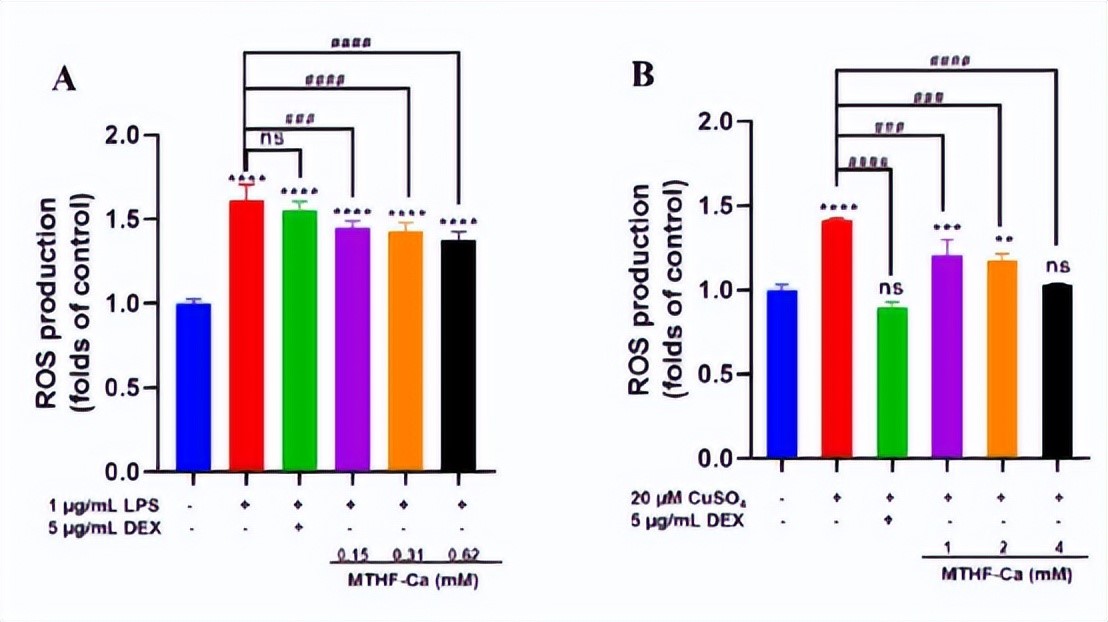
IV. Significant Inhibition of Inflammatory Cell Recruitment by MTHF-Ca
When tissues are damaged, an inflammatory response ensues, leading to the recruitment of immune cells to the affected area. To examine this process, researchers used a tail transection model in zebrafish to observe the migration of neutrophils and macrophages during inflammation.
In the experiment, zebrafish tails were transected and then exposed to either embryo water, 5 μg/mL dexamethasone, or various concentrations of MTHF-Ca (1, 2, 4 mM) for 4 hours. Compared to the untransected control group, tail transection significantly increased the number of neutrophils and macrophages by 5.28-fold and 2.54-fold, respectively.
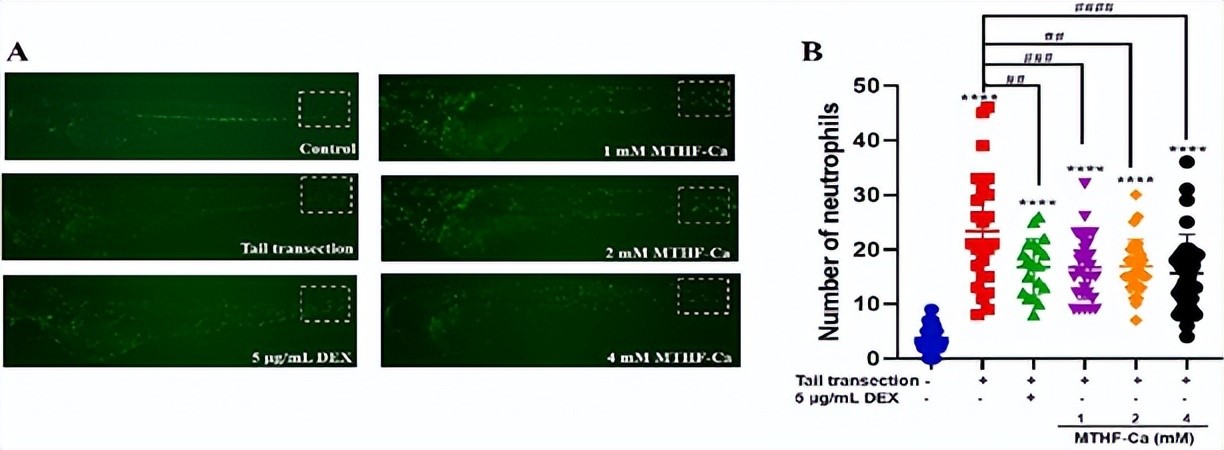
Further analysis revealed that MTHF-Ca significantly inhibited the recruitment of inflammatory cells. Specifically, MTHF-Ca reduced neutrophil recruitment by 28.13% (1 mM), 28.4% (2 mM), and 27.67% (4 mM), and macrophage recruitment by 41.7% (1 mM), 31.04% (2 mM), and 36.2% (4 mM).
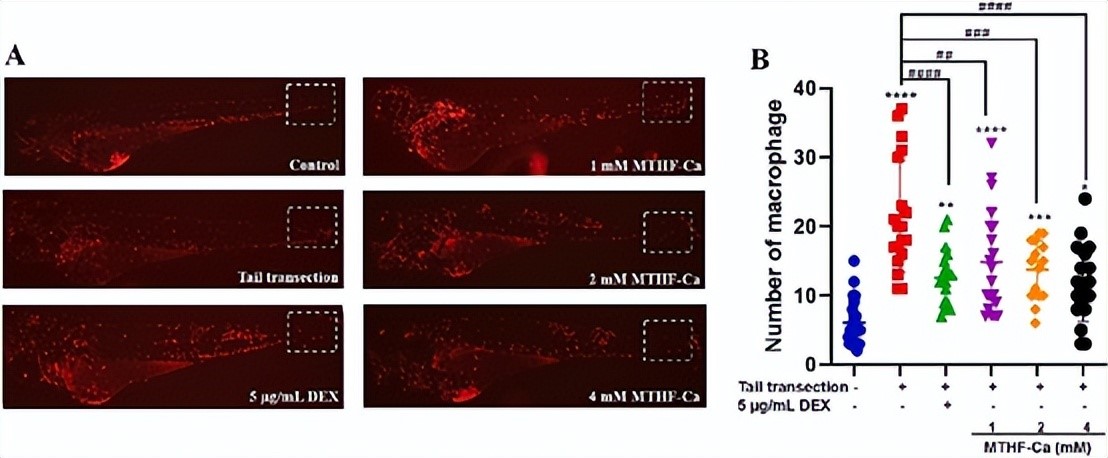
These results indicate that MTHF-Ca effectively reduced the recruitment of inflammatory cells at all tested concentrations, outperforming dexamethasone and highlighting its potential as a potent anti-inflammatory agent.
V. Anti-inflammatory Mechanism of MTHF-Ca in CuSO₄-Induced Zebrafish Model
In the CuSO₄-induced zebrafish inflammatory model, exposure to CuSO₄ led to a significant increase in the number of neutrophils and macrophages by 4.05-fold and 1.75-fold, respectively, confirming the induction of an inflammatory response.
MTHF-Ca significantly attenuated the recruitment of neutrophils, with inhibition rates of 35.48%, 40.02%, and 47.25% at different concentrations, surpassing the 35.7% inhibition rate achieved with dexamethasone.
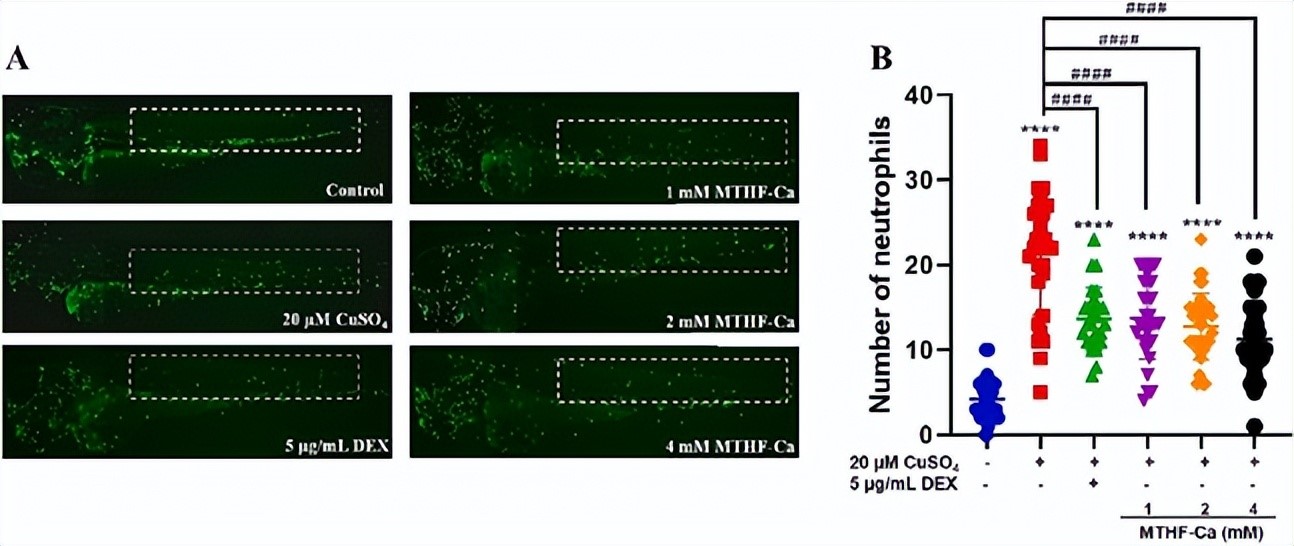
Similarly, MTHF-Ca reduced macrophage recruitment by 26.3%, 24.93%, and 33.93%, compared to the 23.8% inhibition rate with dexamethasone.
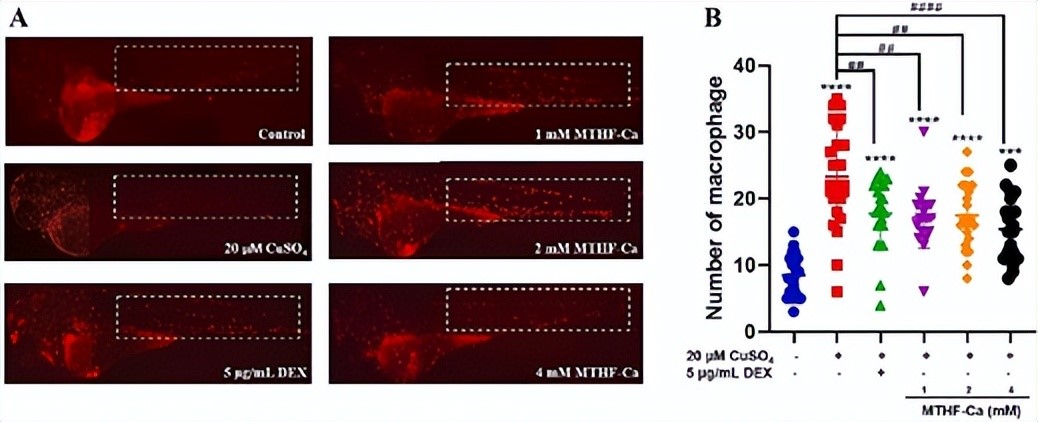
Moreover, MTHF-Ca effectively suppressed the expression of pro-inflammatory cytokines induced by CuSO₄. Two hours post-exposure, the expression of jnk, erk, nf-κb, myd88, p65, tnf-α, and il-1b was significantly elevated. However, treatment with 4 mM MTHF-Ca resulted in inhibition rates of 40.73%, 22.05%, 45.32%, 34.17%, 30.55%, 27.7%, and 51.16%, respectively.
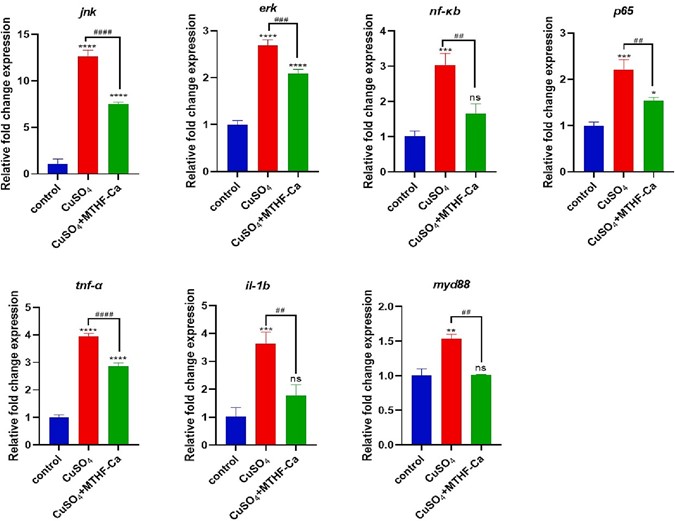
These findings demonstrate that MTHF-Ca not only inhibits the nuclear translocation of NF-κB and reduces ROS production but also suppresses the expression of multiple pro-inflammatory cytokines, thereby enhancing its overall anti-inflammatory efficacy.
VI. Summary and Outlook: The Rise of MTHF-Ca as a New Anti-inflammatory Star
MTHF-Ca exerts its anti-inflammatory effects through a multi-faceted mechanism that includes inhibiting NF-κB activity, reducing ROS levels, inhibiting the recruitment of inflammatory cells, and suppressing the expression of pro-inflammatory cytokines.
These discoveries not only elucidate MTHF-Ca's role in inflammation regulation but also provide a robust scientific foundation for its development as a novel anti-inflammatory agent. Compared to traditional anti-inflammatory drugs, 6S-5-methyltetrahydrofolate calcium (Magnafolate® Pro, MTHF-Ca) offers more pronounced anti-inflammatory effects and a broader regulatory scope, positioning it as a safer and more effective option for the prevention and treatment of inflammation-related diseases.

Scientific Q&A: Answering Your Questions
Q: Can zebrafish experiments predict human effects?
A: With an 82% genetic similarity to humans in inflammatory pathways, zebrafish are internationally recognized as a "gold standard" model for drug screening.
Q: How to scientifically supplement active folate?
A: Opt for products featuring C-crystal patent technology, and a daily intake of 400-800 μg is sufficient. Individuals with abnormal metabolic genes should consider direct supplementation with the active form.
Q: What is Magnafolate® Pro?
A: Magnafolate® Pro is an active folate supplement certified by the FDA NDI, widely used in prenatal and infant nutrition products.
Q: What are jnk, erk, nf-κb, myd88, p65, tnf-α, and il-1b?
A: These are key molecules and signaling pathways involved in the inflammatory response. Jnk and erk are intracellular signaling proteins that regulate inflammation; nf-κb is a transcription factor that controls the expression of pro-inflammatory cytokines; myd88 is an adaptor protein that transmits inflammatory signals; p65 is a subunit of the nf-κb complex; tnf-α and il-1b are pro-inflammatory cytokines that trigger inflammation. MTHF-Ca effectively inhibits these pathways, thereby reducing inflammation.
Q: What is dexamethasone?
A: Dexamethasone is a widely used synthetic corticosteroid that reduces inflammation by inhibiting the production and release of inflammatory mediators. However, long-term use can lead to side effects such as immune suppression and osteoporosis. In contrast, 6S-5-methyltetrahydrofolate calcium (Magnafolate® Pro, MTHF-Ca) offers significant anti-inflammatory benefits with higher safety and tolerability.
Reference:
Bin X-N, Gao Y-B, Pan M, et al. (2023) Anti-inflammatory effects of 6S-5-methyltetrahydrofolate-calcium on RAW264.7 cells and zebrafish. Life Sciences, 327, 121839. DOI: 10.1016/j.lfs.2023.121839.

 Español
Español Português
Português  русский
русский  Français
Français  日本語
日本語  Deutsch
Deutsch  tiếng Việt
tiếng Việt  Italiano
Italiano  Nederlands
Nederlands  ภาษาไทย
ภาษาไทย  Polski
Polski  한국어
한국어  Svenska
Svenska  magyar
magyar  Malay
Malay  বাংলা ভাষার
বাংলা ভাষার  Dansk
Dansk  Suomi
Suomi  हिन्दी
हिन्दी  Pilipino
Pilipino  Türkçe
Türkçe  Gaeilge
Gaeilge  العربية
العربية  Indonesia
Indonesia  Norsk
Norsk  تمل
تمل  český
český  ελληνικά
ελληνικά  український
український  Javanese
Javanese  فارسی
فارسی  தமிழ்
தமிழ்  తెలుగు
తెలుగు  नेपाली
नेपाली  Burmese
Burmese  български
български  ລາວ
ລາວ  Latine
Latine  Қазақша
Қазақша  Euskal
Euskal  Azərbaycan
Azərbaycan  Slovenský jazyk
Slovenský jazyk  Македонски
Македонски  Lietuvos
Lietuvos  Eesti Keel
Eesti Keel  Română
Română  Slovenski
Slovenski  मराठी
मराठी  Srpski језик
Srpski језик 








 Online Service
Online Service